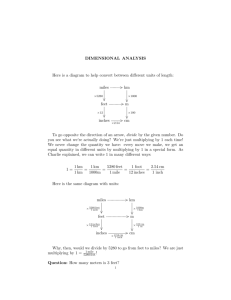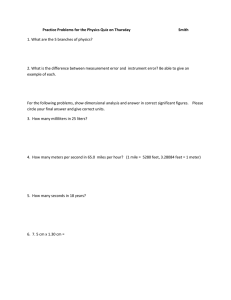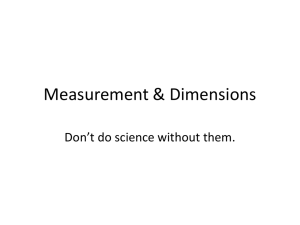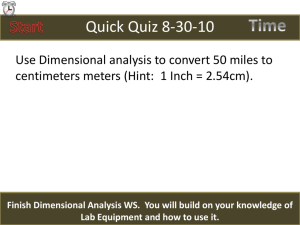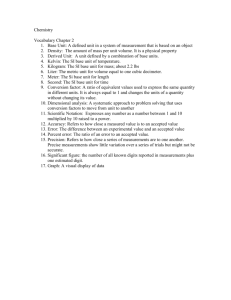Powerpoint Slides
advertisement
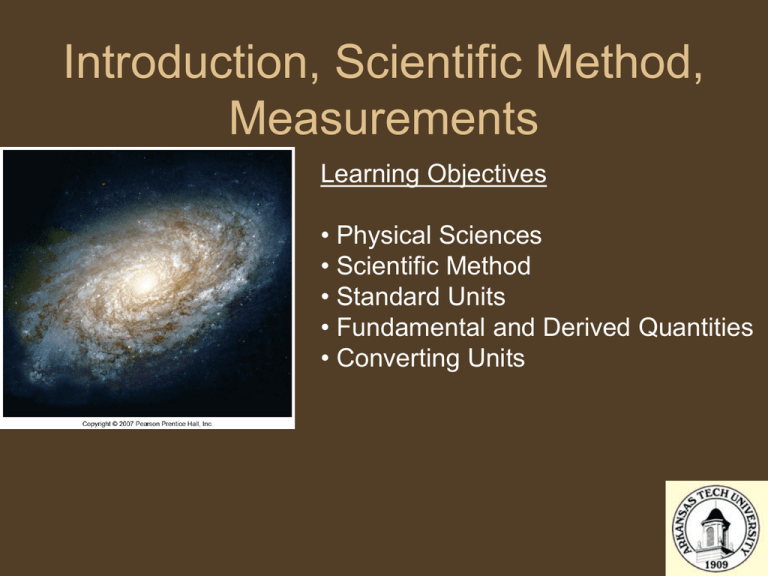
Introduction, Scientific Method, Measurements Learning Objectives • Physical Sciences • Scientific Method • Standard Units • Fundamental and Derived Quantities • Converting Units Physical Sciences SCIENCES SOCIAL SCIENCES (Latin scientia meaning knowledge) An organized body of knowledge about the natural Universe, and the processes by which that knowledge Is acquired and tested NATURAL SCIENCES BIOLOGICAL SCIENCES PHYSICAL SCIENCES PHYSICS Concerned with the basics principles of matter & energy CHEMISTRY Deals with the composition, structure, and reactions of matter. ASTRONOMY METEOROLOGY Study of the universe, Study of the atmosphere, which is the totality of from the ground in outer all matter, energy, space, space. and time. GEOLOGY Science of the planet Earth-its composition, structure, processes, and history. Scientific Method How can we come to understand the Universe? The Universe – all which is observable The part we (think) we understand The part we see but do not understand Epistemology: study (or philosophy) of knowledge. Ways of knowing: Fideism: acceptance of an idea, theory, or explanation only on the evidence of a “higher authority”. Religious beliefs, based on faith or revelation. Science: a systematic method of observation and experimentation. Based on “evidence” and experimental observation Scientific revolution of the 1600s was due primarily to an adoption of the scientific method by Galileo, Newton, and Boyle. Scientific Method Measurement: a quantitative observation Ockham’s Razor: In choosing between two seemingly valid explanations of a particular phenomenon, the simpler and more general one is preferred. Hypothesis: a very tentative, possible answer or an educated guess Experiment: an observation of natural phenomena carried out in a controlled manner Theory: a well-tested explanation of a broad segment of natural phenomena Scientific Method • Limitations: – Deals only with the natural world and never invokes supernatural explanations – Does not attempt to answer questions as the purpose of the universe or life. – These questions are for philosophy and religion Scientific Method Beware of Pseudoscience! Pseudoscience – the dogmatic and irrational belief in an appealing idea that appears scientific but that is not supported by scientific methods. * Astrology (from ancient Babylonian culture) * UFO-ology (popular culture and mistrust of government) * “structure –altered water” (commercial quackery) How can you recognize a pseudoscience? Science Pseudoscience The primary goal of science is to achieve a more complete and more unified understanding of the physical world. Pseudosciences are more likely to be driven by ideological, cultural, or commercial goals. Most scientific fields are the subjects of intense research which result in the continual expansion of knowledge in the discipline. The field has evolved very little since it was first established. The small amount of research and experimentation that is carried out is generally done more to justify the belief than to extend it. Observations or data that are not consistent with current scientific understanding, once shown to be credible, generate intense interest among scientists and stimulate additional studies Observations or data that are not consistent with established beliefs tend to be ignored or actively suppressed Scientific explanations must be stated in clear, unambiguous terms. Pseudoscientific explanations tend to be vague and ambiguous, often invoking scientific terms in dubious contexts. Mathematical Nature of Science • Newton and Leibniz Calculus • Mathematics is the only language precise enough to accurately describe the laws of nature. isomorphism • Skills needed for success in this course – Algebra – Basic Trigonometry – Graphical Analysis Do not worry about your difficulties in Mathematics. I can assure you mine are still greater. – Albert Einstein Measurements - Units We need numbers in order to accurately take measurements • When executing the scientific method we must perform experiments measurements data • Express measurements using units (i.e. metric units, English units, etc.) Unfortunately American students must learn both systems! • Units allow us to describe things numerically • Measurement standards – a fixed and reproducible value for the purpose of taking accurate measurements How do we know the length of a meter, yard? • Human arm, standard for length, cubit – Egyptians • King Loius XIV, length of the royal foot • Distance from equator to north pole • Modern standard, distance light,travels in 1/299,792,458 s The sizes of things: What does 1025 mean? What does 102 mean? 102 = 10 10 = 100 notice that the 2 tells us how many zeros there are in the answer! 10 10 10 10 10 10 10 10 10 10 10 10 10 10 10 10 10 10 10 10 10 10 10 10 10 = 10,000,000,000,000,000,000,000,000 What does 10 -25 mean? What does 10 -2 mean? 10 -2 = 0.1 0.1 = 0.01 notice that the -2 tells us how many places to the left we move the decimal point! 0.1 0.1 0.1 0.1 0.1 0.1 0.1 0.1 0.1 0.1 0.1 0.1 0.1 0.1 0.1 0.1 0.1 0.1 0.1 0.1 0.1 0.1 0.1 0.1 0.1 = 0.0000000000000000000000001 This type of notation is called “scientific notation” it is used to represent very large and very small numbers in a manner that is efficient and easy to do. Units • Mass: the kilogram – One kilogram is the mass of a particular platinumiridium cylinder kept at the International Bureau of Weights and Standards, Sèvres, France. one kilogram weighs slightly less than one kilogram Units • Time: the second – One second is the time for radiation from a cesium-133 atom to complete 9,192,631,770 oscillation cycles. Units • Fundamental units – fundamental because they are the most basic quantities or properties – Length (International System, SI meter (m), British foot (ft)) – Mass (SI gram (gr), British slug (sl)) – Time (SI & British second (s)) • Derived units – combinations of fundamental units – Speed (SI m/s, British ft/s) – Acceleration (SI m/s2, British ft/s2) – Force = mass × acceleration (SI kg·m/s2 = Newton (N), British pounds (lbs) Units MKS : Meter-Kilogram-Second CGS: Centimeter-Gram-Second Derived Unit Quantity MKS CGS Area Length2 m2 cm2 Volume Length3 m3 cm3 Velocity Length/Time m/s cm/s Density mass/volume = mass/Length3 kg/m3 gr/cm3 Acceleration Length/Time2 m/s2 cm/s2 Force mass Acceleration = mass Length/Time2 (kg m)/s2 (gr cm)/s2 Pressure Force / Area = (mass Length/Time2)/Length2 [(kg m)/s2]/m2 [(gr cm)/s2]/cm2 Sometimes even the derived units are called different names because they are so cumbersome. Typically these units are named after a scientist that contributed to it’s origin. Force = mass Acceleration = (kg m)/s2 = NEWTON Converting Units of Measurement – Dimensional Analysis • It is often the case that we must convert from one set of units to another. • Suppose we want to convert 316 ft to its equivalent in meters 0.62 mile 1 km 1000 meters 1 km 12 inches 5280 feet 2.54 cm 100 cm 1 foot 1 mile 1 inch 1 meter these cancel ! Example: How many kilometers is 50,000 inches? 50,000 inches 50,000 1 foot 1 mile 1 kilometer 12 inches 5280 feet 0.62 mile 1x1 x1 kilometers 1.27 kilometers 12 x 5280 x 0.62 left with the units we want ! The order that you apply the conversions makes no difference in the end! Converting Units of Measurement – Dimensional Analysis 1 km 1000 meters 0.62 mile 1 km 12 inches 1 foot 5280 feet 1 mile 2.54 cm 1 inch 100 cm 1 meter If I drive 10 m/s in a school zone posted 20 miles/hour, am I speeding? Here we must convert two things: meters to miles, and seconds to hours 1 kilometers 0.62 miles 10 m / s 1 kilometer 1000 meters 22.3 mph YES ! SLOW DOWN 3600 sec 1 hour Conversions are a breeze with the metric system because it is based on powers of 10! Converting Units of Measurement – Dimensional Analysis Prefix Power Examples Kilo- 1000, 103 Kilometer, Kiloliter, Kilogram Hecto- 100, 102 Hectometer,Hectoliter,Hectogram Deca- 10, 101 Decameter,Decaliter,Decagram m, l, gr 1, 100 meter,liter,gram Deci- 0.1, 10-1 Decimeter,Deciliter,Decigram Centi- 0.01, 10-2 Centimeter,Centiliter,Centigram Milli- 0.001, 10-3 Millimeter,Milliliter,Milligram What if I had 10 milliliters and needed to convert this to kiloliters? 10 mL 1L 1 kL 0.00001 kL 1 10 5 kL 1000 mL 1000 L Converting Units of Measurement – Dimensional Analysis Prefix Power Examples Kilo- 1000, 103 Kilometer, Kiloliter, Kilogram Kind Hecto- 100, 102 Hectometer,Hectoliter,Hectogram Hector Deca- 10, 101 Decameter,Decaliter,Decagram Decked m, l, gr 1, 100 meter,liter,gram Mr. Deci- 0.1, 10-1 Decimeter,Deciliter,Decigram Deci Centi- 0.01, 10-2 Centimeter,Centiliter,Centigram Cinema Milli- 0.001, 10-3 Millimeter,Milliliter,Milligram Monday Kind Hector Decked Mr. Deci at the Cinema on Monday. KHDMDCM Each word represents one of the powers of ten in the metric system!! Converting Units of Measurement – Dimensional Analysis KHDMDCM So let’s look at how this works using the example we just did. What if I had 10 milliliters and needed to convert this to kiloliters? KHDMDCM 10.0 mL = ?? kL KHDMDCM Notice that I had to move over 6 letters to get to the “K” (or Kilo). So this corresponds to the number (and direction) of spaces I have to move my decimal! 10.0 mL = 0.00001 kL Let’s try another example! Go to H-ITT Question Converting Units of Measurement – Dimensional Analysis 1 km 1000 meters 0.62 mile 1 km 12 inches 1 foot 5280 feet 1 mile 2.54 cm 1 inch 100 cm 1 meter We can use converting units to solve some neat problems. How about this. If I know that a stack of 1,000 - $1 bills is = 1 inch in height Could I jump over $1,000,000? Where would we start? 1,000,000 dollars 1 inch 1000 dollars 1,000,000 dollars 1 inch 1000 dollars ??? 1 ft 83 ft 12 inches Dimensional Analysis • Any valid physical formula must be dimensionally consistent – each term must have the same dimensions From the table: Distance = velocity × time Velocity = acceleration × time Energy = mass × (velocity)2
